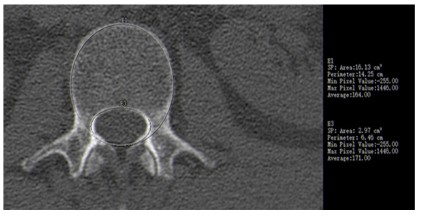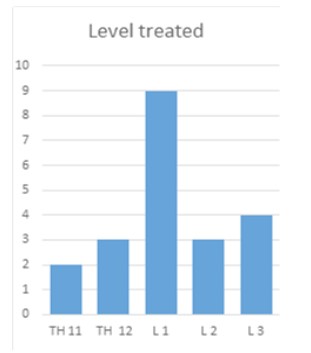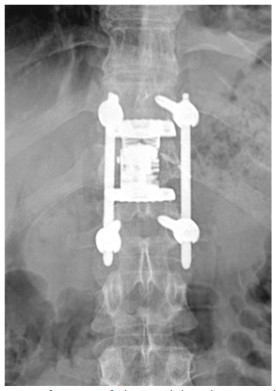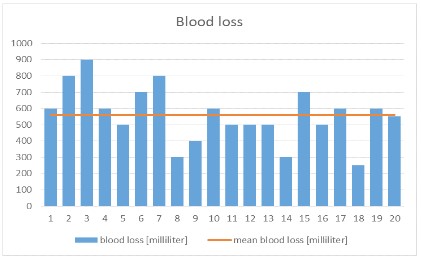Introduction
Vertebral Body Replacement (VBR) is often performed in the
lumbar and thoracolumbar spine. Reasons for this procedure
include trauma, infection, degenerative changes, deformity and
tumor pathologies. It is well known that subsidence is the most
common complication following thoracolumbar vertebral body
replacement (VBR) with expandable cages. It is more often seen
with expandable implants than in cases with non-expandable,
static Vertebral Body Implants (VBI) [1-3]. Failure rates are seen
in cases up to 50% [4]. Subsidence often ends in reoperation because of pseudarthrosis, instability, secondary kyphosis or even
because of new neurological symptoms [5]. Expandable cages
with large endplates are now being used in order to reduce the
subsidence rates. However, these require more elaborate preparations of the vertebral endplates which may lead to higher surgical morbidity [6]. For the traditional VBI morbidity rates of 14%
to 29% are described [6,7]. A secured anti-subsidence capability,
because of a stress distribution on the two endplates interfacing
the VBI, is a large contact area on the bone graft [8]. In using techniques which allow the implantation of intervertebral cages with
a large footprint (Extreme Lateral Interbody Fusion (XLIF)) the
rate of subsidence is 7.5% less than in procedures with smaller
footprints cages (transforaminal lumbar interbody fusion (TLIF))
[9]. Herein we present our experience in the first year with these
new devices and the 30-Day morbidity following vertebral body
replacement.
Method and material
Device
We retrospectively reviewed medical records of all patients
who underwent a corpectomy and implantation of an expandable
cage (Posidon®, Signus Medical LLC , Alzenau, Germany).
Patients
For a distinct interpretability we focused only on cases with one
level of trauma which were operated without additional plating in
the lumbar and thoracolumbar spine. Supplemental dorsal stabilization was done in all cases. We excluded infectious and tumorous
cases as well as those with deformity and degenerative changes.
Data
Demographic data (age, sex), primary diagnosis, operative
data (length of surgery, blood loss), surgical level, preoperative
and postoperative neurologic status, perioperative complications,
length of stay after surgery and measurement of footplate-to-vertebral body endplate ratio were analyzed.
Procedure
An extreme lateral mini-open approach for vertebral body replacement was preformed [10]. The patients were positioned on
their right side for this standard procedure. After a small incision
(5 to 7 cm) above the fluoroscopic marked index segment a blunt
dissection through all muscle layers (external oblique muscle, internal oblique muscle and transverse abdominal muscle) was performed. The retroperitoneal fat was then retracted anteriorly and
the psoas muscle bluntly dissected or mobilized dorsally. Where
necessary the diaphragm had to be transected. After verifying
the level, the adjacent intervertebral discs to the index vertebral body were completely removed after contralateral annulotomy.
Afterwards the VB was resected and the endplates as well as the
distance between the adjacent VB were measured and the device
with the maximum possible surface of footplates was implanted.
Bony autograft was then attached to the VBI.
Footplate-to-vertebral body ratio
Calculation of footplate-to-vertebral body endplate ratio was
done on the basis of the standard preoperative CT-Scan. Endplate
surfaces from the adjacent segments of the index level were measured and calculated (Figure 1). Alternatively surface from the
intraoperative chosen footplates for the expandable cage was calculated and ratio of both was generated.
Results
Between June 2018 and September 2019 the study included
20 consecutive patients who were treated with a vertebral body
replacement. Twelve women and eight men with a mean age of
60.6 years (32 to 72 years) were included. Two female cases had
osteoporosis which was under medical therapy. None of the cases
had neurological deficits preoperatively.
All operations were due to a burst or a split fracture (Type A2
or A4) in the thoracolumbar and lumbar spine. Affected vertebral
bodies were Th 11 (n=2), Th 12 (n=3), L1 (n=9), L2 (n=3) and L 3
(n=4) (Figure 2). All cases underwent an additional dorsal pedicle
screw instrumentation in a separated procedure [11].
Implanted sizes of the footplates of VBI were 2.2 cm x 5.1 cm
(11.22 cm2) in 6 cases, 2.2cm x 4.3 cm (9.46 cm2) in 10 cases and
2.2 cm x 3.5 cm (7.7 cm2) in 4 cases. Mean surface of the foot-plates was 9.66 cm2. Mean surface of adjacent segment endplates
was 12.05 cm2 (range from 10.5 cm2 to 13.4 cm2). Therefore mean
footplate-to-vertebral body endplate ratio was 0.81 (range 0.78 to
0.89). So all cases showed a footplate-to-vertebral body endplate
ratio greater than 0.78 (Figures 3,4).
Our data shows a stable surgical time during the first year. The
mean surgical time was 140.8 min (range 90 to 190 min), the median time was 145.5 min with a normal Gaussian distribution (Figure 5). Mean blood loss was 560 ml (250 ml to 900 ml) (Figure 6)
and the average length of stay was 13 days (5 to 34 days). There
were no surgical complications (e.g. neurological deterioration,
vascular or pulmonary injuries, impaired wound healing).
Discussion
Nowadays Vertebral Body Replacement (VBR) after corpectomy is a standard procedure in spinal surgery. Over the last 50
years surgeons have used materials such as bone grafts, titanium,
glass-ceramics, polymethyl methacrylate and wollastonite [12-14]. Likewise the surgical techniques and approaches evolved into
new techniques with posterior placement of expendable cages in
the lumbar spine [15,16]. Even patient specific three-dimensional-printed polymers are an innovative future trend [17]. Expandable
devices are replacing static vertebral body cages these days [3],
but there is the risk of higher rates of subsidence in expendable
cages [1]. For optimizing biomechanical stability larger endplates
for the implant were developed. One of the first VB implant with
large footplates was the Posidon® (Signus Medical LLC, Alzenau,
Germany).
Patients
Our cohort included 20 consecutive patients who underwent
a two stage thoracolumbar instrumentation. After initial dorsal
pedicle screw instrumentation (short construct) an anterior erection and fixation was done using a one level vertebral body replacement with large endplates in a second operation. The reason
in all cases was an unstable fracture. None of the twelve women
and eight men had neurological symptoms prior to or after surgery. No complications like wound- or deep infection, cerebrospinal fluid leakage, implant failure or dislocation, pneumothorax or
hemothorax occurred. Demographics and spreading of affected
segments showed a typical spreading [18].
Blood loss
When performing a more complex VBR, especially with preparation of the endplates of the adjacent vertebral body, you may
expect a greater loss of blood. It may be indispensable to place
the VBI with large endplates.
The present finding reveals an average blood loss of 560 ml
(250 ml to 900 ml) for the VBR itself (Figure 3). That is in keeping
with normal ranges described in literature. There you can find a
loss of blood for VBR in the lumbar spine for tumor surgery with
an average of 1272 ml [19] and for VBR in fracture cases with a
mean loss of 596.4 ml. Collected data for an update and metaanalysis of anterior spine surgery of recent fractures of the thoracolumbar spine could demonstrate volumes of blood loss be-
tween 600 ml up to 2500 ml [20]. Consequently the use of and VBI
with lager endplates and the necessity of an enlarged preparation
does not determine an increased loss of blood.
Learning curve/duration
To establish the use of a new implant or a new technique you
can expect a learning curve for all users. Especially for a surgical method which requires more elaborate preparation than the
familiar practice. An important point is not to overshoot preparation of endplates which may result in the reduced cortical consistency of adjacent segments and an elevated risk of subsidence.
Our data shows a consistent time of surgery during the learning stages of performing the new technique. A mean time of 140.8
min, a median time of 145.5 min and a normal Gaussian distribution (Figure 3) was documented in the first 20 cases.
Cut-to-closure time, which can be found in the available literature for VBR of thoracolumbar spine, ranges from 180 min up to
330 min [19-22]. So in total, the use of the above described new
VBI does not result in a prolonged surgery time and does not need
extensive practice to get familiar with it.
Endplate
A large surface between the VBI and the endplates of the ad-
jacent vertebral body is supposed to decrease the stress to the
endplates and the rate of subsidence. Three-dimensional patient
specific vertebral body replacement with anatomical interfacing
design shows 75% less stress in a finite element analysis to the
endplates than a design with flat plates [8].
In 2014 Holland et al advocated a footplate-to-vertebral body
ratio greater than 0.5 and an optimal expansion of the expandable
cages in the thoracic spine. They could not evaluate an increased
subsidence rate in the use of expendable cages compared to static
cages [1,23-25]. But in their retrospective analyzed cohort they
found a greater footplate-to-vertebral body ratio for static cages
(0.71) than after implanting an expendable cage (0.63). There
were no significant differences between the two groups in rates
of subsidence (33% expandable cages, 40% static cage).
In our series the mean footplate-to- vertebral body ratio is
0.81. The smallest ratio in our cohort is 0.78. Therefore, all cases have a contact surface at least of three-fourths to the adjacent
segment endplates. This value exceeds the amount which is recommended in the literature so far.
Nevertheless we do not know if a great footplate-to-vertebral
body ratio shows a benefit. Essential issues include subsidence,
consolidation, fusion, loosening and pseudarthrosis. These assessments require further analysis with a long term follow up, a
prospective and randomized study design.
Conclusion
Based on the results of this study, VBR with the new expandable implant for a large bearing surface for anterior stabilization
in the lumbar and thoracolumbar spine after burst fracture is safe
and not associated with a higher surgical morbidity. Particularly
with regard to the necessity of a more elaborate preparation.
There is a good technical possibility to achieve an extensive foot-plate-to-vertebral body ratio. Nevertheless, long term results for
clinical and radiographic follow up with focus on subsidence as
well as fusion is desirable.
Declarations
Acknowledgments: None
Formatting of funding sources: This research did not receive
any specific grant from funding agencies in the public, commercial, or not-for-profit sectors.
Abbreviations: MRI: Magnetic Resonance Imaging; VBL: Vertebral Body; VBI: Vertebral Body Implant; VBR: Vertebral Body
Replacement; XLIF: Extreme Lateral Interbody Fusion; Cm: Centimeter.
References
- Lau D, Song Y, Guan Z, La Marca F, Park P. Radiological outcomes of
static vs expandable titanium cages after corpectomy: a retrospective cohort analysis of subsidence. Neurosurgery. 2013; 72: 529-539.
- Eleraky M, Papanastassiou I, Tran ND, Dakwar E, Vrionis FD. Comparison of polymethylmethacrylate versus expandable cage in
anterior vertebral column reconstruction after posterior extracavitary corpectomy in lumbar and thoraco-lumbar metastatic spine
tumors. European spine journal : official publication of the European Spine Society, the European Spinal Deformity Society, and
the European Section of the Cervical Spine Research Society. 2011; 20: 1363-1370.
- Eleraky MA, Duong HT, Esp E, Kim KD. Expandable versus nonexpandable cages for thoracolumbar burst fracture. World neurosurgery. 2011; 75: 149-154.
- Behrbalk E, Uri O, Parks RM, Musson R, Soh RC, Boszczyk BM. Fusion and subsidence rate of stand alone anterior lumbar interbody
fusion using PEEK cage with recombinant human bone morphogenetic protein-2. European spine journal : official publication of the
European Spine Society, the European Spinal Deformity Society,
and the European Section of the Cervical Spine Research Society.
2013; 22: 2869-2875.
- Arts MP, Peul WC. Vertebral body replacement systems with expandable cages in the treatment of various spinal pathologies: a
prospectively followed case series of 60 patients. Neurosurgery.
2008; 63: 537-544.
- Kalra RR, Schmidt MH. The Role of a Miniopen Thoracoscopic-assisted Approach in the Management of Burst Fractures Involving
the Thoracolumbar Junction. Neurosurgery clinics of North America. 2017; 28: 139-145.
- Han SJ, Lau D, Lu DC, Theodore P, Chou D. Anterior thoracolumbar corpectomies: approach morbidity with and without an access
surgeon. Neurosurgery. 2011; 68: 1220-1225.
- Wang L, Kang J, Shi L, et al. Investigation into factors affecting the
mechanical behaviours of a patient-specific vertebral body replacement. Proc Inst Mech Eng H. 2018; 232: 378-387
- Epstein NE. Review of Risks and Complications of Extreme Lateral
Interbody Fusion (XLIF). Surgical neurology international. 2019;
10: 237.
- Ozgur BM, Aryan HE, Pimenta L, Taylor WR. Extreme Lateral Interbody Fusion (XLIF): a novel surgical technique for anterior lumbar
interbody fusion. The spine journal : official journal of the North
American Spine Society. 2006; 6: 435-443.
- Eck JC. Minimally invasive corpectomy and posterior stabilization
for lumbar burst fracture. The spine journal : official journal of the
North American Spine Society. 2011; 11: 904-908.
- Cotler HB, Cotler JM, Stoloff A, Cohn HE, Jerrell BE, et al. The use
of autografts for vertebral body replacement of the thoracic and
lumbar spine. Spine. 1985; 10: 748-756.
- Scoville WB, Palmer AH, Samra K, Chong G. The use of acrylic plastic for vertebral replacement or fixation in metastatic disease of
the spine. Technical note. Journal of neurosurgery. 1967; 27: 274-
279.
- Dvorak MF, Kwon BK, Fisher CG, Eiserloh HL, Boyd M, et al. Effectiveness of titanium mesh cylindrical cages in anterior column reconstruction after thoracic and lumbar vertebral body resection.
Spine. 2003; 28: 902-908.
- Hunt T, Shen FH, Arlet V. Expandable cage placement via a posterolateral approach in lumbar spine reconstructions. Technical note.
Journal of neurosurgery Spine. 2006; 5: 271-274.
- Morales Alba NA. Posterior placement of an expandable cage for
lumbar vertebral body replacement in oncologic surgery by posterior simple approach: technical note. Spine. 2008; 33: E901-905
- Amelot A, Colman M, Loret JE. Vertebral body replacement using patient-specific three-dimensional-printed polymer implants
in cervical spondylotic myelopathy: an encouraging preliminary
report. The spine journal : official journal of the North American
Spine Society. 2018; 18: 892-899.
- Salas N, Prebet R, Guenoun B, Gayet LE, Pries P. Vertebral body
cage use in thoracolumbar fractures: outcomes in a prospective
series of 23 cases at 2 years’ follow-up. Orthopaedics & traumatology, surgery & research : OTSR. 2011; 97: 602-607.
- Ernstberger T, Kogel M, Konig F, Schultz W. Expandable vertebral
body replacement in patients with thoracolumbar spine tumors.
Archives of orthopaedic and trauma surgery. 2005; 125: 660-669.
- Allain J. Anterior spine surgery in recent thoracolumbar fractures:
An update. Orthopaedics & traumatology, surgery & research :
OTSR. 2011; 97: 541-554.
- Sasani M, Ozer AF. Single-stage posterior corpectomy and expandable cage placement for treatment of thoracic or lumbar burst
fractures. Spine. 2009; 34: E33-40.
- Takeuchi T, Yamagishi K, Konishi K, et al. Radiological Evaluation
of Combined Anteroposterior Fusion with Vertebral Body Replacement Using a Minimally Invasive Lateral Approach for Osteoporotic Vertebral Fractures: Verification of Optimal Surgical Procedure.
Journal of clinical medicine. 2022; 11.
- Jandial R, Chen MY. Modified lateral extracavitary approach for
vertebral column resection and expandable cage reconstruction of
thoracic spinal metastases. Surgical neurology international. 2012;
3: 136.
- Jandial R, Kelly B, Chen MY. Posterior-only approach for lumbar
vertebral column resection and expandable cage reconstruction
for spinal metastases. Journal of neurosurgery Spine. 2013; 19:
27-33.
- Holland CM, Bass DI, Gary MF, Howard BM, Refai D. Thoracic lateral extracavitary corpectomy for anterior column reconstruction
with expandable and static titanium cages: clinical outcomes and
surgical considerations in a consecutive case series. Clinical neurology and neurosurgery. 2015; 129: 37-43.






